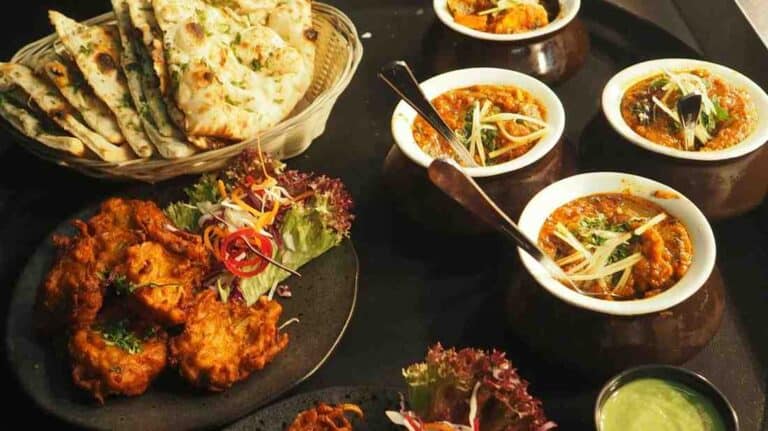Tasting Asia: The Best Local Dishes
Asia is a continent that lives and breathes through its food. Every dish tells a story – a blend of history, culture, and geography served on a plate. From smoky street stalls in Bangkok to bustling food markets in Tokyo, Asia offers a sensory overload that travelers can’t resist. In 2025, culinary tourism is bigger than ever, and there’s no better way to understand a country than by tasting its local dishes. This guide takes you on a delicious journey through Asia’s most iconic, flavorful, and unforgettable foods – from spicy curries to delicate dumplings, each bite brings you closer to the heart of the continent.
Why Asia’s Food Scene Is Unmatched
Asia’s culinary diversity comes from centuries of trade, migration, and cultural exchange. The region’s ingredients – rice, noodles, herbs, spices, and sauces – may seem simple, but each culture transforms them into something extraordinary. Whether you’re sampling fiery chili pastes in Southeast Asia or the subtle balance of umami in Japan, Asian cuisine thrives on contrast: hot and cold, sweet and sour, soft and crunchy. Every country has its own flavor identity, yet all share one common truth – food is a way of life.
Japan: Tradition Meets Precision
Sushi – A Masterpiece of Simplicity
Sushi is Japan’s most famous export, but its true beauty lies in its simplicity. Fresh fish, perfectly seasoned rice, and delicate presentation make it an art form rather than just a meal. The best sushi is often found in small local bars where chefs spend years mastering their technique. In Tokyo or Osaka, tasting omakase (chef’s choice) sushi allows you to experience the freshest ingredients and seasonal variations that define Japanese cuisine.
Ramen – Comfort in a Bowl
Ramen is more than just noodles in broth – it’s Japan’s ultimate comfort food. Each region has its signature version: Tokyo’s soy-based broth, Sapporo’s rich miso, or Hakata’s creamy tonkotsu made from pork bones. Slurping is not only allowed but encouraged; it’s a sign of appreciation. A steaming bowl of ramen after a long day of exploring Japan is pure satisfaction.
Thailand: The Land of Balance and Spice
Pad Thai – The Global Favorite
No dish captures Thailand’s spirit better than Pad Thai. This stir-fried noodle dish combines rice noodles, tofu, shrimp, eggs, peanuts, and lime – a harmony of sweet, salty, and tangy flavors. Although popular worldwide, authentic Pad Thai from a Bangkok street vendor is unmatched. The secret lies in the tamarind sauce and the smoky flavor that comes from high-heat cooking.
Green Curry – Creamy and Fiery
Thai green curry is a vibrant mix of green chilies, coconut milk, and aromatic herbs like lemongrass and kaffir lime leaves. It’s spicy, fragrant, and comforting – best served with jasmine rice. Each spoonful offers a burst of flavor that represents the essence of Thai cuisine: bold, layered, and perfectly balanced.

China: Ancient Flavors with Modern Twist
Peking Duck – Crispy Perfection
Beijing’s iconic Peking Duck has been a royal dish for centuries. The duck is roasted until the skin turns crispy and golden, then sliced thinly and served with pancakes, scallions, and hoisin sauce. The ritual of wrapping duck slices into delicate rolls turns dining into a cultural experience. It’s a must-try for anyone visiting China.
Xiaolongbao – The Famous Soup Dumplings
Originating from Shanghai, Xiaolongbao are delicate dumplings filled with pork and flavorful broth. Each bite bursts with warmth and richness, offering a true taste of Chinese craftsmanship. Eating them requires a bit of skill – you gently bite the top, sip the soup, and then savor the rest.
India: A Feast of Spices and Traditions
Butter Chicken – A Global Classic
Born in Delhi, butter chicken (murgh makhani) is one of India’s most beloved dishes. Marinated in yogurt and spices, the chicken is grilled and then simmered in a creamy tomato sauce infused with butter and garam masala. It’s indulgent, aromatic, and perfect with naan or basmati rice.
Masala Dosa – South India’s Crispy Delight
Masala dosa is a South Indian staple made from a fermented rice-and-lentil batter. The thin, crispy crepe is filled with a spiced potato mixture and served with coconut chutney and sambar. It’s light, flavorful, and perfect for breakfast or lunch – a true example of India’s regional diversity.
Vietnam: Freshness in Every Bite
Pho – The Soul of Vietnam
Pho is more than soup – it’s the symbol of Vietnamese comfort food. This noodle dish features a delicate broth simmered for hours with bones, spices, and herbs, topped with rice noodles, beef or chicken, and a handful of fresh herbs. Whether enjoyed from a street-side stall in Hanoi or a modern café in Ho Chi Minh City, Pho reflects Vietnam’s love for balance and freshness.
Banh Mi – East Meets West
A culinary legacy of French colonialism, Banh Mi combines a crispy baguette with Vietnamese fillings like grilled pork, pickled vegetables, cilantro, and chili. It’s a perfect fusion of texture and flavor – crunchy, spicy, and satisfying in every bite.
Indonesia: Island Flavors and Bold Spices
Nasi Goreng – The Ultimate Fried Rice
Indonesia’s national dish, Nasi Goreng, turns simple ingredients into magic. Fried rice is flavored with sweet soy sauce, garlic, shallots, and chili, often topped with a fried egg. It’s a dish that captures Indonesia’s diverse culinary influences, from Malay to Chinese flavors, all in one plate.
Satay – Skewers of Perfection
Satay consists of marinated meat skewers grilled over an open flame and served with a rich peanut sauce. Found across Southeast Asia, Indonesian satay stands out for its smoky flavor and slightly sweet glaze. It’s street food at its finest – simple, flavorful, and deeply satisfying.
South Korea: Fermented Flavors and Fiery Dishes
Bibimbap – A Harmony in a Bowl
Bibimbap translates to “mixed rice,” but it’s much more than that. It’s a vibrant bowl filled with rice, vegetables, meat, egg, and spicy gochujang (chili paste). Each ingredient represents a color and flavor, creating balance and nutrition. Mixing it together before eating is part of the joy.
Kimchi – The Heart of Korean Cuisine
No Korean meal is complete without kimchi – fermented cabbage or radish with chili, garlic, and salt. It’s spicy, tangy, and full of probiotics. Koreans eat it with almost everything, from stews to rice dishes, and it’s now celebrated worldwide for its health benefits and unique flavor.
Malaysia: The Melting Pot of Asia
Laksa – A Bowl of Heritage
Laksa is a spicy noodle soup that reflects Malaysia’s multicultural identity. It combines Chinese noodles, Malay spices, and Indian influences. Variations include curry laksa with coconut milk or asam laksa with tangy tamarind broth. Each region has its signature version, but all are rich, complex, and comforting.
Nasi Lemak – A True Malaysian Icon
Considered Malaysia’s national dish, Nasi Lemak is a fragrant rice meal cooked in coconut milk and pandan leaves. It’s served with sambal (chili paste), fried anchovies, boiled egg, and peanuts. Traditionally eaten for breakfast, it’s so beloved that Malaysians now enjoy it any time of day.
The Philippines: Bold Flavors and Family Traditions
Adobo – The National Comfort Dish
Adobo is the heart of Filipino cooking. Meat, usually chicken or pork, is marinated in vinegar, soy sauce, garlic, and bay leaves, then simmered until tender. The balance of salty, tangy, and savory makes it irresistibly good. Every region – and even every household – has its own version, reflecting the country’s rich diversity.
Halo-Halo – A Sweet Summer Treat
Halo-Halo, meaning “mix-mix,” is the Philippines’ favorite dessert. Shaved ice, sweet beans, fruit, and jellies are layered with condensed milk and topped with ice cream. It’s colorful, refreshing, and perfectly suited to the country’s tropical climate.
Singapore: A City of Culinary Crossroads
Hainanese Chicken Rice – Simple and Sublime
This deceptively simple dish is Singapore’s pride. Poached chicken is served with fragrant rice cooked in chicken broth, accompanied by chili sauce and ginger paste. Its flavor depends on technique – every element must be perfectly balanced. It’s proof that great food doesn’t need to be complicated.
Chili Crab – Sweet, Spicy, and Messy
Chili Crab defines Singaporean seafood. The crab is stir-fried in a thick, tangy sauce made from chili, tomato, and egg, creating a sticky, flavorful coating. It’s messy to eat but absolutely worth it. Locals and visitors alike agree it’s one of Asia’s most indulgent dishes.
Exploring Beyond the Plate
Asia’s best local dishes aren’t just about taste – they’re about connection. Eating street food in Bangkok, sharing a family meal in Hanoi, or watching a sushi chef in Tokyo tells you more about a place than any guidebook. Food brings people together, crossing language and cultural barriers. For travelers, it’s the easiest way to experience authenticity. Each dish reflects centuries of history, migration, and creativity – a living legacy passed down through generations.
Tips for Food Travelers
1. Eat Where the Locals Eat: Street food vendors and small eateries often serve the freshest, most authentic dishes.
2. Respect Local Customs: In some cultures, eating with your hands or removing shoes before dining is a sign of respect.
3. Stay Safe: Choose busy stalls with high turnover and watch food being cooked fresh.
4. Be Open-Minded: Trying something unfamiliar can lead to your favorite new dish.
5. Learn a Few Food Words: Knowing how to say “no spicy,” “vegetarian,” or “thank you” makes dining smoother.
The Taste of Discovery
Asia’s local dishes are more than meals – they’re experiences, memories, and moments of discovery. Each country offers something unique, yet all share a deep love for flavor, community, and creativity. From Japan’s delicate sushi to Thailand’s fiery curries, Asia invites travelers to taste its diversity one bite at a time. So when you plan your next trip, skip the fancy restaurants and dive into the local markets, humble stalls, and family kitchens. Because in Asia, the best food isn’t found on a menu – it’s found in the stories behind every dish.







